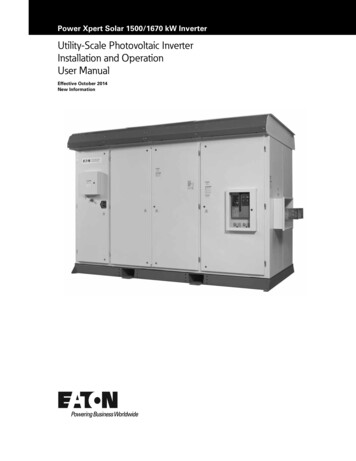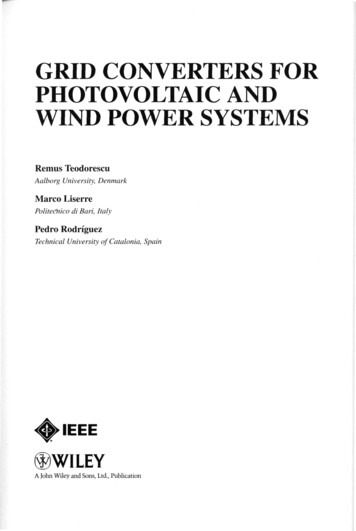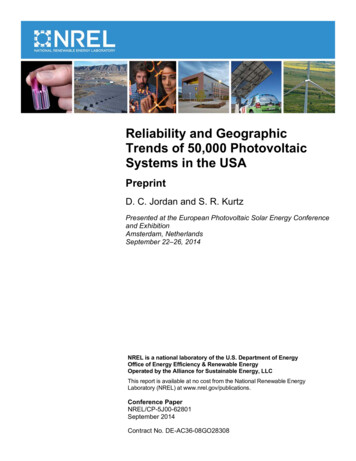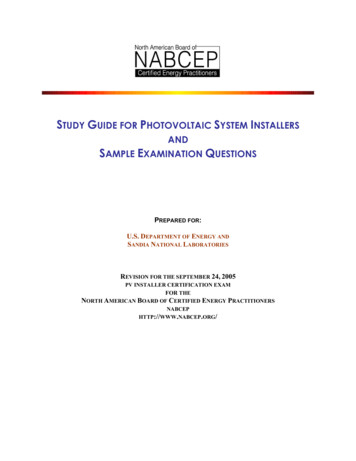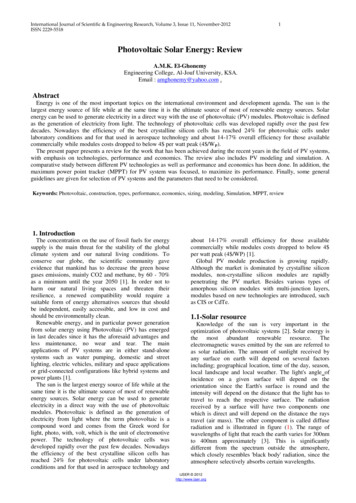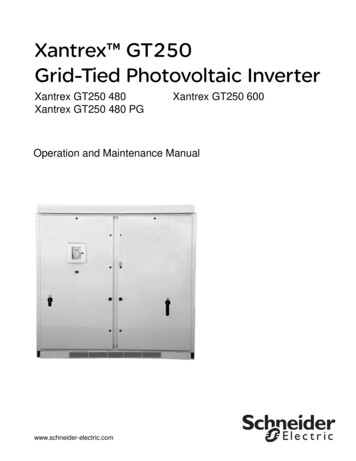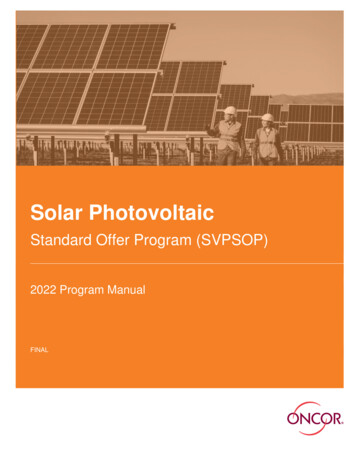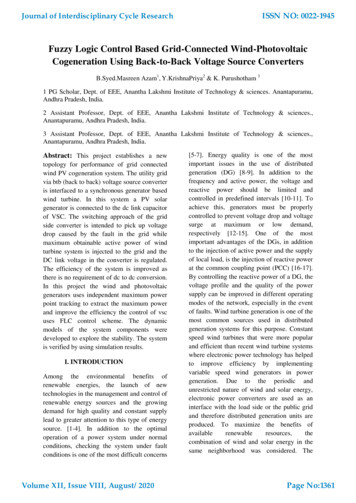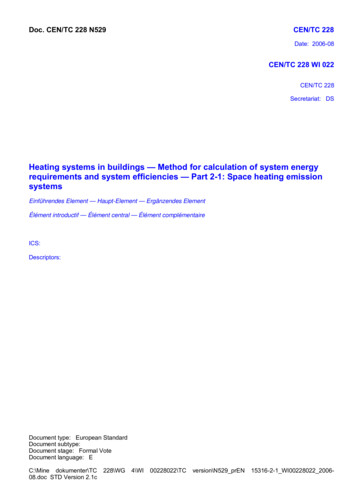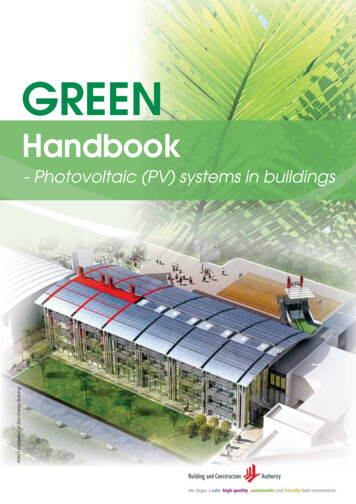
Transcription
GREENHandbook- Photovoltaic (PV) systems in buildings
Note:This handbook is subject to revision from time to time. Nothing herein shall be construed to exempt any personsubmitting an application or any plans from otherwise complying with the provisions of the Building Control Actor any rules and/or guidelines made thereunder or any Act or rules and/or guidelines for the time being inforce. The Building and Construction Authority reserves the right to change its policies and/or to amend anyinformation in this document without prior notice.Copyright @ 2008 Building and Construction Authority, Singapore. All rights reserved. This document or any partthereof may not be reproduced for any reason whatsoever in any form or means whatsoever and howsoeverwithout the prior written consent and approval of the Building and Construction Authority.Whilst every effort has been made to ensure the accuracy of the information contained in this publication, theBuilding and Construction Authority, its employees or agents and members of the Working Committee shall not beresponsible for any mistake or inaccuracy that may be contained herein and all such liability and responsibility areexpressly disclaimed by these said parties.This publication include information of suppliers who have, in one way or another, contributed to the developmentof this publication. The Building and Construction Authority does not endorse the products included. It is theresponsibility of the users to select the appropriate products and ensure the selected products meet theirspecific requirements.ISBN 978-981-08-0578-4
FOREWORDWith the formation of the Clean Energy Programme Offi ce, a whole of governmenteffort to develop capability in clean energy, the Building and Construction Authority(BCA) took the initiative to prepare this document as a handbook to complementEMA’s Handbook for Photovoltaic Systems. As this is a relatively new area in Singapore,the document will be updated as and when there is new development.The aim of this guide is to share and provide the industry and homeowners theprocedures and the good practices in the design, planning and implementation of aphotovoltaic system in a building development.This guide also provides examples of how photovoltaic (PV) are successfully integratedinto buildings overseas, illustrating how BIPV can both be an energy generator aswell as a versatile building material for the envelope.03Tan Tian ChongDirectorTechnology Development DivisionBuilding And Construction Authority03
ACKNOWLEDGEMENTWe would like to thank the following organisations for their support and contributions in the developmentof this guide:i)EDB/EMA/URAii)Schüco International KGiii)Grenzone Pte Ltdiv)SolarGy Pte Ltdv)Interlink Power System Pte Ltdvi)Phoenix Solar Pte Ltdvii)Sun Technics Pte Ltdviii)Renewpowers Technologies Pte LtdBCA would also like to specially thank the following persons for their contributions in the developmentof the handbook:i)A/P Stephen K. Wittkopf and Ms Anupama Rana Pandey (NUS)ii)Dr Jiang Fan (Singapore Polytechnic)04
CONTENTS1Introduction062Design and Installation072.1 Types of photovoltaic system072.2 EMA’s requirements082.3 Where PVs can be installed in a building082.4 URA’s requirements on development planning control102.5 BCA’s requirements on structural safety & lightning protection112.6 Guide For Owners - Installation Of Solar Panels or Photovoltaics (PV)122.7 Design and Installation Checklists13Operation & Maintenance153Appendix A: Contact Information16Appendix B: Examples of BIPV Applications in Buildings1705
11.1IntroductionPhotovoltaic (PV in short) is a form of clean renewable energy. Most PV modules use crystalline siliconsolar cells, made of semiconductor materials similar to those used in computer chips. Thin film modulesuse other types of semiconductor materials to generate electricity. When sunlight is absorbed bythese materials, the semi-conductor material in the PV cells is stimulated by the photons of thesunlight to generate direct electrical current (DC). They will work as long as they are exposed todaylight. The electricity generated is either used immediately or is stored (eg. in batteries) for futureuse. Solar modules themselves do not store electricity.1.2The objective of this handbook is to provide developers, architects, other professionals as well asinterested homeowners with some basic information on how to approach, plan and implement aphotovoltaic system to generate electric power in a building development.1.3The contact information for enquiries on installation of PV systems in building is summarised inAppendix A.1.4For general information on BIPV, the IEA (International Energy Agency) website, http://www.bipvtool.comis a useful reference.06
2Design and Installation2.1 Types of Photovoltaic SystemPhotovoltaic systems can be classified based on the end-use application of the technology. Thereare two main types of PV systems; grid-tie system and off-grid system.Grid-Tie System2.1.1 In a grid-tie system (Figure 1), the output of the PV systems is connected in parallel with the utilitypower grid. In this way, the power supply drawn from the utility grid will be correspondingly reducedby the amount of power generated by the PV system. On the other hand when there is little or nooutput from the PV system due to cloudy weather or at night, the electricity drawn from the utilitygrid will be correspondingly increased. Hence there is no need to have storage batteries.Figure 1: Basic grid-tie system (Courtesy of SMA)Off-Grid System2.1.2 In an off-grid system (Figure 2), batteries for energy storage are required to provide electricity underconditions when there is little or no output from the PV system. Currently, such PV systems are alreadycompetitive in isolated sites where the electricity grid is far away. Off-grid systems usually power DCloads, such as telecoms systems, rural lighting systems, parking sign lights, lightings in parks etc.If required, off-grid systems can also include an inverter to drive AC loads.07
2Design and InstallationFigure 2: Basic off-grid system2.2 EMA’s requirementsBeing electrical power systems, PV installations must meet EMA’s requirements. The Energy MarketAuthority (EMA) has published on its website, a Handbook for PV Systems to cover the electricalaspects of PV systems1. The Handbook provides information on the licensing, market and technicalrequirements to ensure safety, reliability and power quality of consumers’ electrical installations andof the power grid.2.3 Where PVs can be installed in a buildingThere are many ways to install PV systems in a building. For existing buildings, the most commonmanner without drastically affecting its appearance is to mount the PV modules on a frame onthe roof top. Typically, they are mounted above and parallel to the roof surface with a standoff ofseveral centimetres (recommended 10 cm) to reduce module temperature through air circulation.Ideally, they should also be installed facing north-south orientation to maximise the amount of solarenergy received. Singapore’s proximity to the Equator means the module’s compass orientation isnot critical. Laying the modules flat will maximise exposure to the sun. As flat-mounted modules mayget dirty from trapped rain water and dust, it is better to mount the modules at an angle (10-15 forframed modules, or as little as 3-5º for unframed modules) to allow rain water to run off properly. ThePV modules should be free of shade. Shading of any cell of a module may reduce the output of theentire module drastically. Therefore, shadows cast by tall trees and neighbouring buildings (includingthose to be built in future) should be avoided.1The Handbook for Photovoltaic (PV) Systems is available at the following EMA website: p08
Figure 3: Roof Mounted PV System (Courtesy of InterlinkFigure 4: PV array mounted at an angle on the buildingPower System)roof topIn a new development, besides mounting on the roof top, the PV modules or panels could in a creative,aesthetically-pleasing manner be integrated into the building facade (this form of PV is commonly knownas Building Integrated Photovoltaic or BIPV in short). This could be on any part of the roof or external wallsthat is well-exposed to sunlight e.g. skylights, claddings, windows, external shading devices. It could alsobe integrated into external structures such as canopies, car park shelters and railings.Figure 5: PV modules integrated into facade (BIPV)Figure 6: PV modules integrated into skylight canopy(Courtesy of Biopolis)(Courtesy of Savannah Condominium)More examples of how BIPVs can be integrated into a building are found in Appendix B.09
2Design and Installation2.4 URA’s requirements on development planning controlAt present, there are no specific requirements or controls by URA (Urban Redevelopment Authority)on the use of materials such as PVs. However, conservation projects or projects within the CentralArea are subject to URA’s Urban Design evaluation process.Guidelines on Conservation and Development Control2.4.1 Architects are advised to refer to URA’s guidelines on conservation, urban design and developmentcontrol. The guidelines are available at the following URA website respectively:Conservation %20Guidelines.pdfUrban Design guidelines:http://www.ura.gov.sg/cudd/ud handbook/ud handbook.htmlDevelopment Control handbook.html2.4.2 The URA general email address and contact number on Development Control matters is: Email: ura dcd@ura.gov.sg Tel: 6223 4811The respective telephone contact and email address of the Planner-In-Charge, by planning area,for enquiries on Development Control matters can be assessed through the following website:http://www.ura.gov.sg/dc/phone email/contact planner.html10
2.5 BCA’s requirements on structural safety and lightning protectionStructural Safety2.5.1 For new building developments, the design for the structure must take into consideration the loadingof the PV installations, just like any other equipment mounted on the building structure.2.5.2 For existing buildings, the service of a professional structural engineer may be required to carry outan inspection of the roof structure and do a calculation on the structural loading. This could bethrough the PV contractor (System integrator or SI in short) or directly by the building owner. If the roofis unable to withstand the loading2 of the PV system, there will be a need for structural plans to besubmitted to BCA for approval. The application guideline is available at the following BCA tural plan application.html2.5.3 If BIPV glass is used as a glazing material and not as an add-on to existing facade, it will be treatedlike any other glazing material. No special approval for the use of BIPV will be needed. If BIPV isinstalled on an existing facade as an add-on, the design for the mounting system must complywith building and structural design code.Lightning Protection2.5.4 Given its location, PV systems are likely to be hit when lightning strikes in the vicinity. As lightningsurges in the PV system can cause damages to the PV modules and inverters, care must be takento ensure that proper lightning protection is provided for the system and entire structure. Theinverters should be protected by appropriately rated surge arrestors on the DC side. Structuresand module frames must be properly grounded.2The structural loading requirement is as follows:(a) For non-accessible roof, the loading must be below 0.5 kN/m2.(b) For accessible roof, the loading must be below 1.25 kN/m2.11
2Design and Installation2.6 Guide For Owners - Installation Of Solar Panels or Photovoltaic (PV)StartOwner can check with URA directly whether PV can beinstalled on the building’s facade/roof or Owner can alsoapproach a System Integrator (SI)* for such adviceOwner to appoint SI to take full responsibility of the work.SI to engage professional engineer to assess the conditionof building structure and loading of PV.NoComply with loadingrequirements?YesOwner/SI to appoint a Licensed Electrical Worker (LEW)to be responsible for the electrical works associatedwith the PV systemBuilding plans must besubmitted to BCA forcommencement ofstructural strengtheningworks.YesAppointed LEW to submitApplication Form to SP Services(SPS)SP PowerGrid (SPPG) to evaluate and discuss with LEW onthe technical requirements, and on the technicalspecifications of the PV system to be submittedComply with technicalrequirements?NoYesSPPG to advise connection schemeLEW to carry out or supervise the electrical works associatedwith the PV System (including connection to the powergrid and/or electrical installation), and inform bothSPPG and SPS when completed.SI:i) should provide an operation and maintenance manualincluding any authority approval (if applicable)handover to homeownerii) should provide a warranty of 12 months of defects liability period.EndUseful Contact information:1. BCA General Enquiry:Tel: 6325 77202. URA General Enquiry:Tel: 6223 4811Email: ura dcd@ura.gov.sg3. EMA Electricity Licences:Tel: 6835 8068/Teo Nan Shing4. EMA Licensed Electricalworkers: Tel: 6835 80605. EMC Market rules etc:Tel: 6779 3000/Poa Tiong Siaw6. SPPG connection to grid:Tel: 6823 8553/James Goh* System Integrator (SI) in PV industry refers to a person or company that provides design, supply, delivery,installation, commissioning and maintenance of a photovoltaic power system.12
2.7 Design and Installation ChecklistsNo.Checklist for Design and Installation1Select a location, check with URA whether PV can be installed inbuilding’s facade/roof and set your budget2Determine energy requirement and estimate of system size3Site survey for space needed and access for maintenance4Engage a licensed electrical worker(LEW) if your proposed PV system:i) is to be connected to the electrical installation within your premises; and/orii) is to be connected and operated in parallel to the power gridCompletedThe appointed LEW will be responsible for the design and implementationof the connection of your PV system to the electrical installation and/orpower grid5Selection of module, type and mounting method6Inverter selection to match PV array No. of inverters needed Select inverter type Location of inverters (accessible for inspection and maintenance)7Finalise the mounting system8Ensure there are fixing and mounting points available9Ensure the structure for mounting is safe Additional loading by PV system is considered Wind loading is considered Waterproofing is not compromised during installation10Solar access Ensure location mounted will get maximum sunlight Choose a location that is unshaded13
2Design and Installation2.7 Design and Installation ChecklistsNo.Checklist for Design and Installation11Modules are installed at optimum orientation (North-south)12Modules are mounted at a tilt angle (10 to 15 degrees for framed modules, oras low as 3-5º for unframed laminates) for self-cleaning13Sufficient ventilation space behind array for cooling purposes14Cables used must meet sufficient current-carrying capacity and are suitablyrated for the environment usage. DC cables must be single-core,double-insulated. Cable insulation on outdoor cables must withstand hightemperatures and UV exposure for 20 years. PVC and XLPE cables areinadequate and must not be exposed to the elements. (Cable design mustcomply with CP5)15Determine if lightning Protection System is needed (Design must comply withCP16 and CP33)16Ensure that the PV module frame is earthed17Finalising the Inverter and AC wiring system18During installation PV system should be installed by qualified/experienced system installers safety rules must be observed, installer must wear PPE only proper certified safety equipment can be used e.g. scaffolding, stepladders etc.19Cables must be properly connected, secured and routed20Ensure continuity and insulation tests are done21Completion of testing & system commissioning22System, documentation/manual handover to owners14Completed
3Operation & Maintenance3.1As there are usually no moving parts in PV installations, minimal maintenance is needed. However,routine maintenance is required to ensure that the system is performing properly. It is a goodpractice for PV contractor (or System Integrator) to provide an Operation & Maintenance manualto the owner. The manual should include basic system data, test & commissioning data, O&M dataand warranty information.3.2The PV modules require routine visual inspection for signs of damage, dirt build-up or shadeencroachment. Although it is usually designed and installed to be self-cleaning through rainwater, the modules should be hosed down if there is a build-up of dust. It is not uncommon for PVperformance to improve slightly the next day after rain.3.3Periodically, system fixtures must be checked for corrosion. This is to ensure the PV system is safelysecured.3.4Any PV system connected to the electrical installation of a building, is considered part of theelectrical installation. The licensed electrical worker (LEW) appointed by the building owner isresponsible for maintaining the electrical installation to ensure electrical safety.Recommended Preventive Maintenance Works for Photovoltaic System3.5Preventive maintenance works should be carried out every six (6) months.3.6The following table indicates the components/equipments and the corresponding remedial actionsto be carried out during the preventive maintenance /ActionPhotovoltaicModules1. Dust/debris on surface.2. Ensure no physical damage onsurface.3. Check for loose wire connection.4. Check for wiring conditions.1. Wipe clean. Do not use any solventsother than water!2. Recommend replacement.3. Retighten connection.4. Replace wiring when necessary.Inverter1. Check functionality.2. Check for loose wiring connection.3. Check for abnormal operatingtemperature.1. Recommend replacement.2. Retighten connection.3. Recommended replacement.3.Lightning /Surge VoltageProtection1. Retighten connection.1. Check for loose wiring connection.2. Replace wiring when necessary.2. Check for all wiring conditions.3. Replace when necessary. Ensure to3. Check fuses, blocking diodes, circuituse dc-rated components on the dcbreakers, surge arrestors.side!4. Check functionality.4. Replace when necessary.4.Cabling /Junction Box1. Visually check for wear and tear.2. Check for loose connections.1.2.1. Replace when necessary.2. Retighten connection.15
Appendix A: Contact InformationFor enquiries on installation of PV systems in building:(1)(2)(3)16General Enquiry onBuildings issuesGeneral Enquiry onDevelopment ControlDevelopment Control,by Planning AreaBuilding And Construction Authority (BCA)Email: bca enquiry@bca.gov.sgTel: 6325 7720Urban Redevelopment Authority (URA)Email: ura dcd@ura.gov.sgTel: 6223 4811Urban Redevelopment Authority (URA)Planner-In-Charge, by planning area:www.ura.gov.sg/dc/phone email/contact planner.html
Appendix B: Examples of BIPV Applicationsin Buildings1.0 Building Integrated PhotovoltaicsPhotovoltaics when integrated in buildings serve many functions. It not only generates electricity butalso serves as building envelope, structural support, waterproofing, insulation, shading, solar thermalcollection and also as Photovoltaic art.European experience has so far proven Photovoltaics system as an energy generator as well asversatile building material. Its integration in building envelope is possible in different ways andrecent developments in solar technology are further set to widen its application in buildings. Withso many dif ferent shapes, sizes, color and applications to choose from designers are able touplif t their creativity to a level which is environmentally friendly, energy efficient, comfortable, multifunctional and aesthetically attractive.Applications of photovoltaics in following areas of building are possible; Facade and balustrades Roof, Skylight and Canopy Shading devices Photovoltaic ArtFollowing sections illustrate the design potential of photovoltaics by looking at examples of how PVsystems can be integrated into buildings.1.1 PV Facade and balustrades1.1.1 Zero Energy Building, SingaporeThis would be Singapore’s first retrofitted Zero energy building and is a research collaborationbetween National University of Singapore and Building & Construction Authority. The building entirelyoperates on clean energy from the photovoltaics. Energy generation being main objective, theproject a) also serves as a BIPV demo site to present solutions for adoption by local building industryand b) it provides opportunity for research including quantitative and qualitative performanceevaluation and comparison.PV panels in the roofs of large curved PV roof, Walkway shelter and Carpark shelter generate almost100% of the electricity used by the building. PV panels with first generation and second generationsilicon cells are utilized in these areas to maximize the energy generation.Based on their applicability and suitability PV panels of different generations are applied in variousbuilding components; first generation PV modules over large curved PV roof and Walkway shelter,Amorphous PV laminates over Carpark shelter and Sunshades, Amorphous PV modules in balustrade,and unique story-telling of evolution of Photovoltaics by facade integrated PV panels ranging from“first generation to third generation” in staircase facade both opaque and semi-transparent.17
Appendix B: Examples of BIPV Applicationsin BuildingsBuilding name:Zero Energy BuildingOwner:Building and Construction Authority of SingaporeLocation:SingaporeBuilding type:InstitutionalCompletion:Expected to be completed by middle of 2009Working groups: Lead organization:Building and Construction Authority Principal:A/P Stephen Wittkopf (BIPV and Daylighting)Investigators::A/P Lee Siew Eang (Energy efficiency and management)A/P Wong Nyuk Hien (Natural ventilation and Greening) Project Manager:Beca Carter Hollings & Ferner (SE Asia) Pte Ltd Project architects:DP Architects Pte Ltd M&E engineers:Beca Carter Hollings & Ferner (SE Asia) Pte Ltd Structural engineers: Beca Carter Hollings & Ferner (SE Asia) Pte Ltd Quantity Surveyers: Davis Langdon & Seah Singapore Pte LtdType of PV integration:All major BIPV areas: Roof, Facade, Shading device,Balustrade and CanopyType of PV cell technology: All major PV cell technology: First generation (Mono crystalline andPolycrystalline Silicon cells), Second generation (Amorphous Silicon cells) andThird generation(Dye-sensitized cells) both opaque and semi-transparentPV area:1295 m2PV system power:171 kWpEstimated energy output:186,000 kWh / yrEstimated Yield:1088 kWh / kWp/ yrFig (1) East Elevation of Zero Energy Building18
1.1.2 Doxford Solar Office, United KingdomBuilding name:Doxford Solar OfficeOwner :Akeler Developments LtdLocation:Sunderland, United KingdomBuilding type:CommercialCompletion:1998Working groups Project architects:Studio E Architects Ltd Structural engineers: Whitby and Bird Partnership Ltd PV design:Studio E Architects Rybka Battle Building services:Rybka Battle Contractors:Bowmer and Kirkland PV manufacturer:KyoceraType of PV integration:FacadeType of PV cell technology: Polycrystalline siliconPV area:640 m2PV system power:73 kWpEstimated energy output:113,000 kWh / yrYield:1548 kWh / kWpInformation courtesy of:Schüco International KG and:IEA Photovoltaic Power Systems ProgrammeThe building’s south facade is inclined, blue colored curtain wall. Almost 70% of it is covered by semitransparent silicon crystal cells photovoltaic panels. The facade encloses an atrium which gets aninteresting light and shadow effect from the PV facade.Fig (2) Building exterior 334Fig (3) Building interior view 4Photographs courtesy of Schüco International KGPhotographs courtesy of Dennis Gilbert and IEA Photovoltaic Power Systems Programme19
Appendix B: Examples of BIPV Applicationsin Buildings1.1.3 Solar-Fabrik AG, GermanyBuilding name:Solar Fabrik AGOwner :Solar Fabrik AGLocation:Freiburg, GermanyBuilding type:CommercialCompletion:1999Working groups Project architects:Rolf & Hotz, Freiburg General contractors: Freyler Industriebau GmbH, KenzingenType of PV integration:FacadeType of PV cell technology: Mono-crystalline SiliconPV area:575 m2PV system power:56.5 kWpEstimated energy output:45,000.0 kWh / yrYield:800 kWh / kWpInformation courtesy of:Solar Fabrik AGTwenty percent of the building’s electrical power is supplied by solar modules. Photovoltaic has multiplefunctions. It is used to shade and prevent the glass-clad factory from overheating whilst generatingelectricity. It serves as a major architectural design element of the building as well as a showcase of thelatest PV technologies of that time.Fig (4) Building exterior 55Photographs courtesy of Solar Fabrik AG20Fig (5) Building interior view 5
1.1.4 Zara Fashion House, GermanyBuilding name:Zara Fashion HouseOwner :BFW GmbH & Co KGLocation:Cologne, GermanyBuilding type:CommercialCompletion:2003Working groups Project architects:Feinhals Architects PV manufacturer:SOLON AG für Solartechnik PV manufacturer:Schüco International KG Structural engineers: Fassade Hohe StraßeType of PV integration:FacadeType of PV cell technology: Poly-crystalline SiliconPV system power:12 kWpInformation courtesy of:SOLON AG für SolartechnikFaçade consists of 16 different types of special modules, which are imbedded in insulation glasspanes. This allows the photovoltaic module to generate electricity while acting as a part of thebuilding’s cladding. Point brackets hold the laminated solar insulation glass panes in the mullion-andtransom construction, and electrical circuit points and ventilation slits are located discreetly on theback of the module. To prevent output loss through shading, the whole structure was designed withmultiple independent power units.Fig (6) Building exterior 66Fig (7) Building exterior 6Photographs courtesy of Constantine Meyer and SOLON AG für Solartechnik21
Appendix B: Examples of BIPV Applicationsin Buildings1.1.5 Private Residence in Rosrath, GermanyBuilding name:Private residence in RosrathLocation:Cologne, GermanyBuilding type:ResidentialPV manufacturer:Schott Solar GmbHType of PV integration:Facade, skylight and canopyType of PV cell technology: Amorphous SiliconInformation courtesy of:Transparentglass-glassWIBATEC GmbH and Schott Solar GmbHamorphoussiliconPVpanels resemble tinted glass. They are availablein various color and transparency. They are alsoavailable in different thickness and composition ofthe glass. This allows building owner and designersto design energy effi cient, aesthetically pleasantand electricity generating buildings.Fig (9) Building interior view 778Photographs courtesy of WIBATEC GmbH and Schott Solar GmbHPhotographs courtesy of WIBATEC GmbH and Schott Solar GmbH22Fig (10) Canopy 8
1.1.6 Großhadern Clinic, GermanyBuilding name:Großhadern clinicOwner :Großhadern clinicLocation:Munich, GermanyBuilding type:HospitalWorking groups:Schüco International KGType of PV integration:BalustradeType of PV cell technology: Multi-crystalline SiliconPV area:53 m2PV system power:5 kWpInformation courtesy of:Schüco International KGSemi-transparent glass/glass Photovoltaic modules were used in balconies. The Photovoltaic integratedbalustrade has enhanced the facade design whilst ensuring safety of the occupants and energygeneration. They are also perfect in allowing good visibility whilst protecting privacy.Fig (11) Building exterior 99Fig (12) Building exterior 9Photographs courtesy of Schüco International KG23
Appendix B: Examples of BIPV Applicationsin Buildings1.2 PV roof, skylight and canopy1.2.1 Sydney Olympic Village, AustraliaBuilding name:Sydney Olympic villageOwner :Olympic Co-ordination AuthorityLocation:Newington Suburb, Homebush Bay, Sydney, AustraliaBuilding type:ResidentialCompletion:1999Working groups Project architects:Henry Pollack Architects (co-ordinators), Virginia Kerridge, Grose Bradley,Gordon & Valich, Order Architects, Howard Tanner & Associates, TonkinZulaikha, Richard Huxley Project engineers:Connell Wagner, BP Solar and Pacific Power Building developers: Mirvac LendLease PV installers:BP Solar Structural installation Contractors:Civil & Civil (Lend Lease Projects) PV manufacturer:BP SolarType of PV integration:RoofType of PV cell technology: Mono-crystalline siliconPV area:575 m2PV system power:629 x 1 kWpEstimated energy output:1400-1500 kWh / yr per systemInformation courtesy of:IEA Photovoltaic Power Systems ProgrammeFig (13) Building exterior 1010Fig (14) Building exterior 10Photographs courtesy of BP Solar and and IEA Photovoltaic Power Systems Programme24
The project is the world’s largest solar village showcase for the Olympics. Following extensive prototypingand full scale mock ups of various roof integrated (PV) system design options the fi nal product consistedof a metal sub-tray waterproof roof sheet on which frameless BP Solar high effi ciency Saturn PV modulelaminates were fastened down using six custom designed diamond shaped mounting clips.Fig (15) Building exterior 1111Photographs courtesy of Mirvac lendlease and and IEA Photovoltaic Power Systems Programme25
Appendix B: Examples of BIPV Applicationsin Buildings1.2.2 Mont Cenis Academy, GermanyBuilding name:Mont-Cenis AcademyOwner :Akademie Mont-Cenis,Entwicklungsgesellschaft Mont-Cenis, HerneLocation:Herne, GermanyBuilding type:Public / CommercialCompletion:1999Working groups Project architects:Jourda Architects, Paris Project architects:HHS Planer Architekten BDA, Kassel, Germany Project management : dmp architekte
Photovoltaic systems can be classifi ed based on the end-use application of the technology. There are two main types of PV systems; grid-tie system and off-grid system. Grid-Tie System 2.1.1 In a grid-tie system (Figure 1), the output of the PV systems is connected in parallel with the utility power grid.
